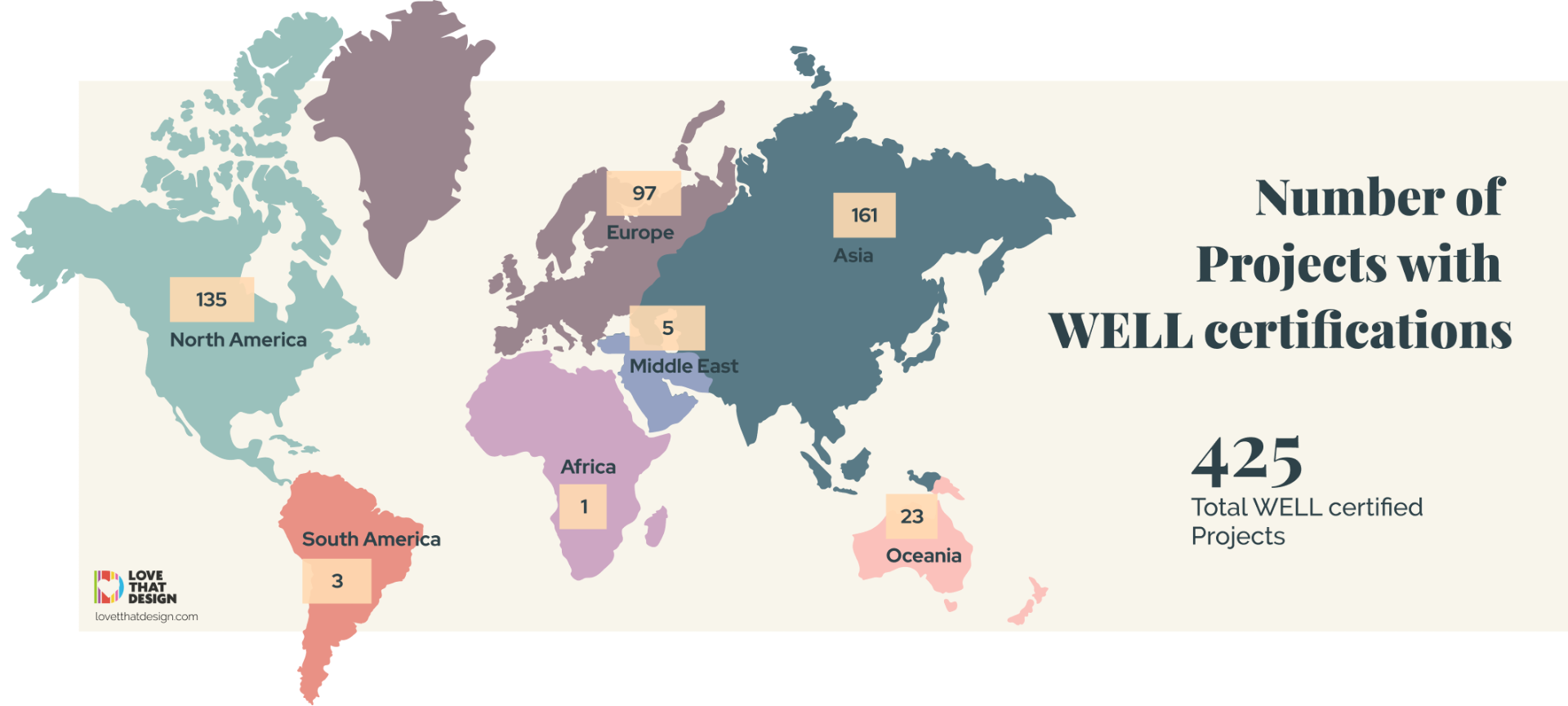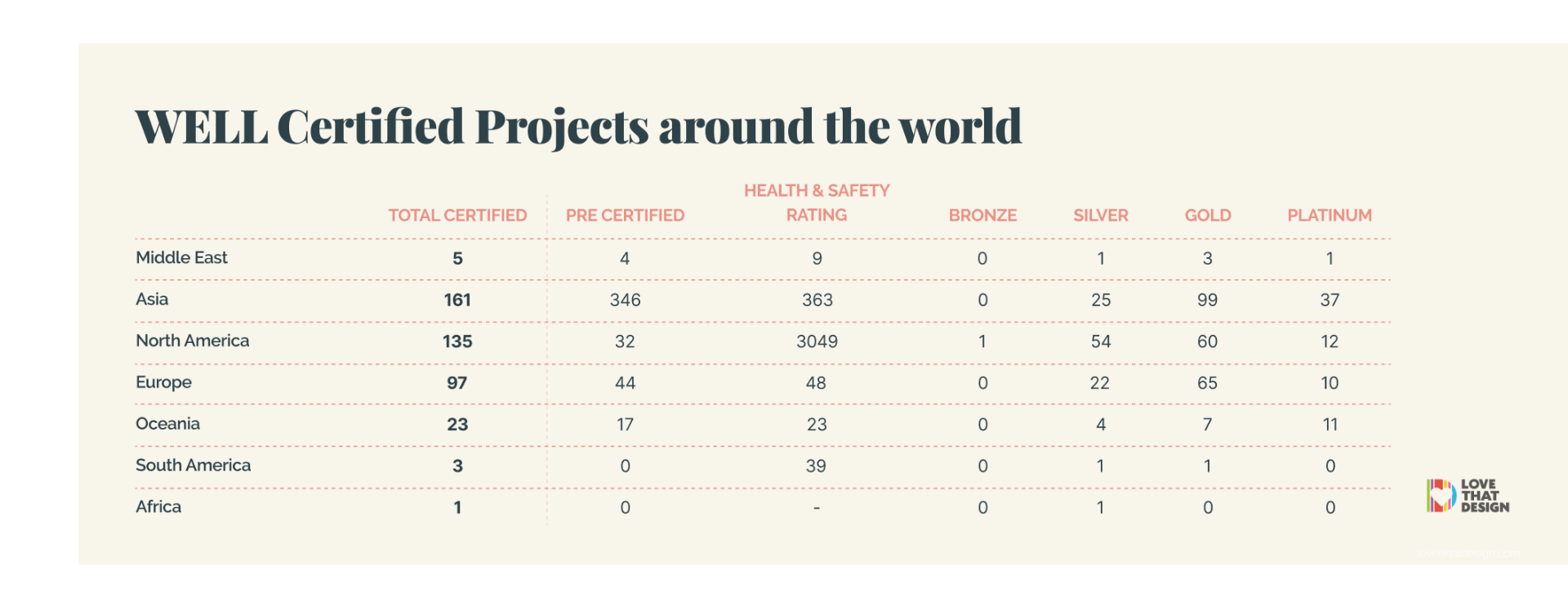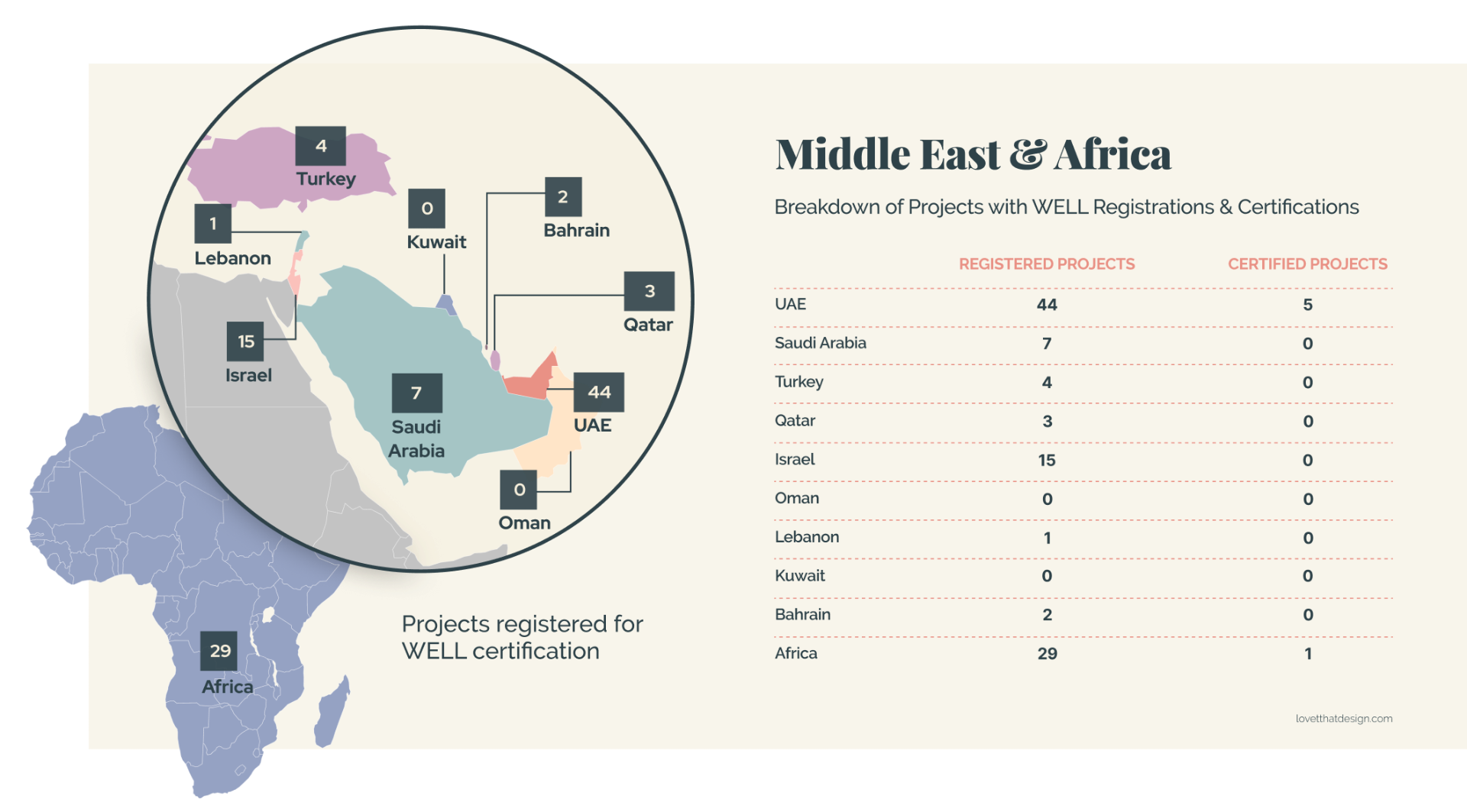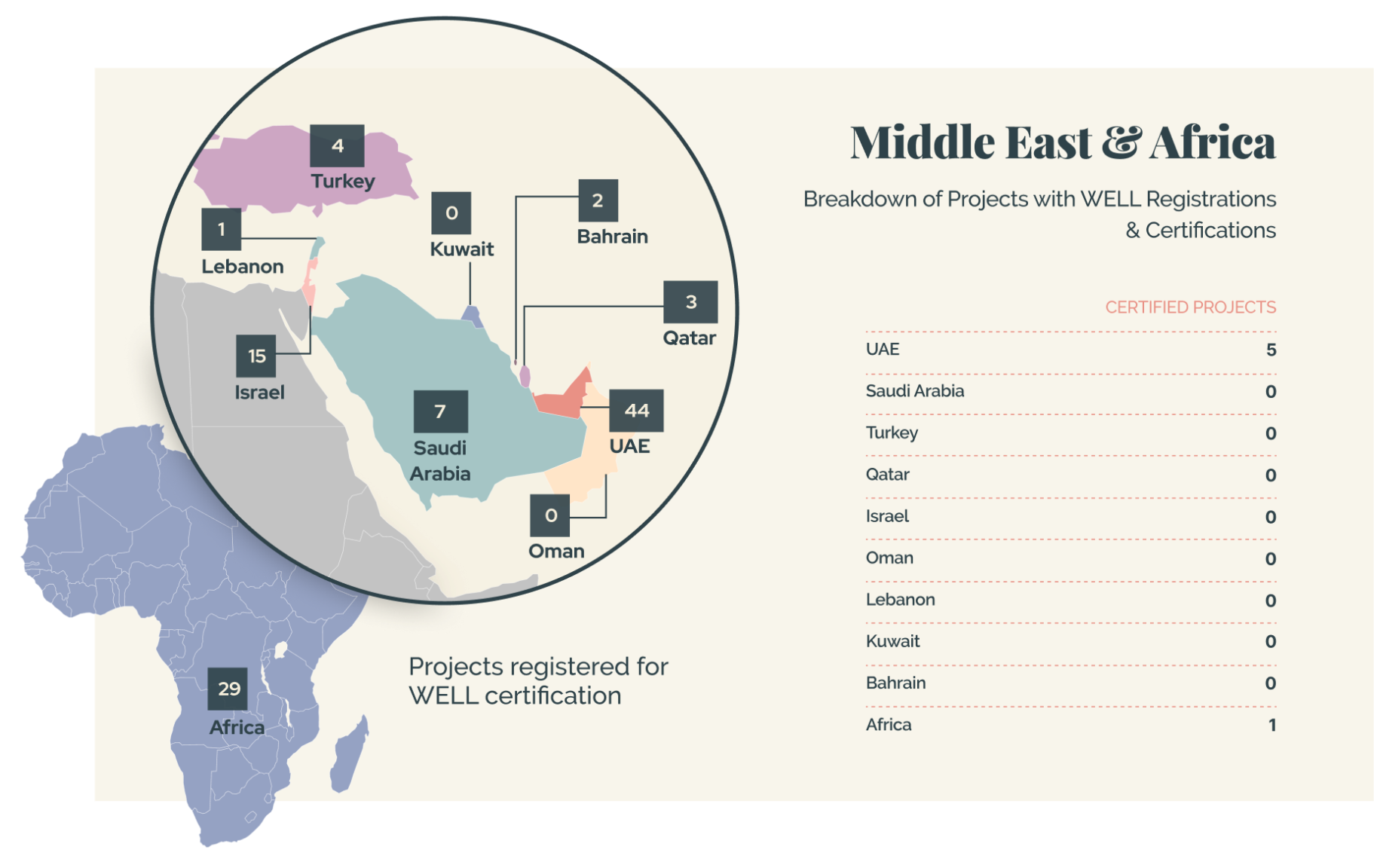Our previous stats driven article on LEED certifications count and comparison showed that the US and many parts of Europe are still leaps and bounds ahead of the MEA region (in fact, the rest of the world) within the area of sustainable design. Nevertheless, LEED certifications rank higher in numbers regionally as compared to WELL, where the certification count is much, MUCH lower. Part of the reason for this huge gap is because LEED was established nearly two decades ago, as compared to WELL, which was only launched by the IWBI (International WELL Building Institute in 2014. LEED also focuses on the environmental impact of a built project, such as water efficiency, indoor environmental quality and energy usage. From a construction standpoint, this proves to be a certification with more quickly attainable checks as a lot of measures are already in place within the build process.
WELL, on the other hand, measures the building and organisation’s ability to deliver an environment that enhances human health and well-being in a sustainable manner, with the least amount of impact on the planet. And now, after the launch of WELL v2, there are a fair number of measures to take and boxes to tick before one can achieve that status.

We spoke to Jessica Rose Cooper, Chief Commercial Officer at the International Well Building Institute (IWBI), regarding the broad global adoption of standards and the increasing popularity of WELL 2.0

JESSICA COOPER, Chief Commercial Officer, International WELL Building InstituteWELL Faculty, LEED AP, NCIDQ
As Chief Commercial Officer at the International WELL Building Institute (IWBI), Jessica oversees the end-to-end customer experience with WELL, helping project teams around the world enhance human health and wellness through the built environment. An avid public speaker, Jessica has also led many presentations and technical workshops to business and real-estate professionals in cities worldwide.
Jessica is a WELL Faculty and one of the first WELL Accredited Professionals, having completed a provisional WELL training at the Cleveland Clinic in February 2015 and then achieving the formal certificate in October 2015. A LEED Accredited Professional since 2008, Jessica also holds a certificate in Green Professional Building Skills Training: Construction Management. Jessica is a licensed interior designer and holds an NCIDQ Certificate. She graduated from Cornell University with a Bachelor of Science in Design and Environmental Analysis.
How will the new WELL 2.0 encourage more clients to opt for this certification?
WELL v2 is designed to help buildings and organisations to deliver more thoughtful and intentional spaces that enhance human health, well-being and equity. It is backed by the latest scientific research and informed by the best practices available today. WELL v2 is built on the pioneering foundation of the first version of the WELL Building Standard (WELL v1), and the v2 pilot. It is the most rigorously tested and vetted version of the WELL Building Standard to date, and draws expertise from thousands of WELL users, practitioners, medical professionals, public health experts and building scientists around the world.
Since its launch in 2020, the latest version of WELL has spurred broad adoption around the world, in part, because it is accessible, equitable and scalable. More and more clients are engaging with WELL because there are many ways to get started. The certification offers a holistic approach, and can be applied to a building, space, or an urban development project.

What are the broad steps involved in getting certified?
Achieving the certification requires the implementation of strategies that span ten concepts (Air, Water, Nourishment, Light, Movement, Thermal Comfort, Sound, Materials, Mind, and Community, plus an additional category that awards Innovation). Projects pursuing WELL Certification can earn points based on achieving various policy, design and operational strategies, and meeting specific performance outcomes. Certification occurs at one of four certification levels, Bronze, Silver, Gold or Platinum, depending on how many health-promoting criteria are successfully implemented.
What is the WELL Health-Safety Rating?
The WELL Health-Safety Rating for Facility Operations and Management is derived from a subset of features from WELL v2 that focus on operational and policy based strategies that address immediate and serious health concerns in buildings. The WELL Health-Safety Rating is focused on five key themes: keeping spaces clean and sanitised, assessing air and water quality, providing essential health benefits and services, communicating health and safety efforts, and helping everyone prepare for future emergencies. Projects achieve the rating when they have successfully implemented at least 15 criteria.
The WELL Portfolio program offers a scalable, enterprise-wide approach to improve human health and well-being holistically across a real-estate portfolio. It enables organisations to implement WELL strategies incrementally, achieving the WELL Health-Safety Rating, WELL Certification and other awards along the way. Participation in the program also results in a WELL Portfolio Score that serves as a benchmark for organisations to measure progress internally and externally, such as in ESG reporting.
What are some of the key aspects of WELL v2 for global adoption?
WELL v2 provides project teams with flexible pathways to achieve certification. The dynamic scorecard gives project teams more freedom to prioritise the strategies that are most relevant to them, so they now have more choices for completing WELL Performance Verification.
Specifically, project teams can schedule their onsite performance testing through a network of Performance Testing Organisations, giving them more flexibility in measuring their performance outcomes. These organisations are third parties with credentialed Performance Testing Agents who can be contracted by project teams to conduct onsite testing.
IWBI provides a high-touch approach to supporting customers on their journey with WELL. When you engage with WELL, you receive dedicated coaching support from our global technical team, helpful resources to navigate the criteria and documentation requirements, an intuitive digital platform to support the process, and much more. Plus, the suite of enhancements you’ll find in WELL v2 is aimed at making WELL more flexible, inclusive and optimised for all types of projects in every part of the world. We understand that health concerns vary globally, which is why we’ve created more pathways in WELL that accommodate localised adaptations.
“As we emerge from the COVID-19 pandemic, it has never been more important to deploy our buildings – our homes, our offices, our schools – as vehicles for public health. Human health is inextricably linked to both the health of our planet and the strength of socioeconomic institutions that support everyday life. We are optimistic that corporations, the capital markets, and society at large will come out of this crisis stronger and smarter, and the importance of human health to the global economy will be even more broadly acknowledged.”
– Jessica Rose Cooper, Chief Commercial Officer at IWBI
How can we promote the adoption of WELL methods and certifications in the MEA region?
The Middle East and Africa is an emerging yet fast-growing market for WELL, and we have been delighted by the growth and traction that WELL has gained over the past year. Several countries are now engaging with WELL from across the region, including the United Arab Emirates (UAE), Israel, Saudi Arabia, Egypt, Turkey, Qatar, Lebanon and Bahrain in the Middle East, and South Africa, Nigeria, Kenya and Tanzania in Africa.
Pioneering projects in the UAE are paving the way for future adoption of WELL across the region. For example, the UAE Prime Minister’s Office has been WELL Certified at Platinum level. Additionally, Hamdan Bin Mohammed Smart University (HBMSU) was the first university in the Middle East to achieve the WELL Health-Safety Rating, and is pursuing WELL Certification, demonstrating leadership in supporting the health, safety and well-being of students, staff and educators. In other sectors within the UAE, Zulekha Hospital, Alpin Limited and Dubai Police have also achieved WELL Certification. Success with these early projects will have far reaching influence and enable other organisations to follow. We are excited to see the MEA region is growing rapidly.

Any increase in WELL Practitioners?
Our global WELL community is continuously growing. In the past year, the network of WELL Accredited Professionals (WELL APs), many of whom are architects, designers and consultants, grew by 80 percent. We now have almost 18,000 professionals who have either registered for or achieved the WELL AP credential around the world. Many of our WELL Faculty members are also architects, designers and consultants. We encourage practitioners in the MEA region to participate in the WELL AP and WELL Faculty programs so that they will be able to support the growing market needs.
How does WELL compare to other leading certification bodies in the region and the world?
First of all, WELL is aligned with various building certifications in the market. As an example, IWBI works with Green Building Councils in countries across the region for the alignment between WELL and LEED.
WELL is the leading global standard to holistically benchmark and advance health, well-being and equity through design interventions, operational protocols and commitments that foster a culture of health. It is an evidence-based and performance-verified certification program, meaning that projects must prove that a space is not only designed for health, but that it performs for health. Engagement with WELL continues to grow exponentially, and many organisations are now using the framework to demonstrate their commitment to human health and well-being across their entire real-estate portfolios, addressing both new and existing assets.
As we emerge from the COVID-19 pandemic, it has never been more important to deploy our buildings – our homes, our offices, our schools – as vehicles for public health. Human health is inextricably linked to both the health of our planet and the strength of socioeconomic institutions that support everyday life. We are optimistic that corporations, the capital markets, and society at large will come out of this crisis stronger and smarter, and the importance of human health to the global economy will be even more broadly acknowledged.







